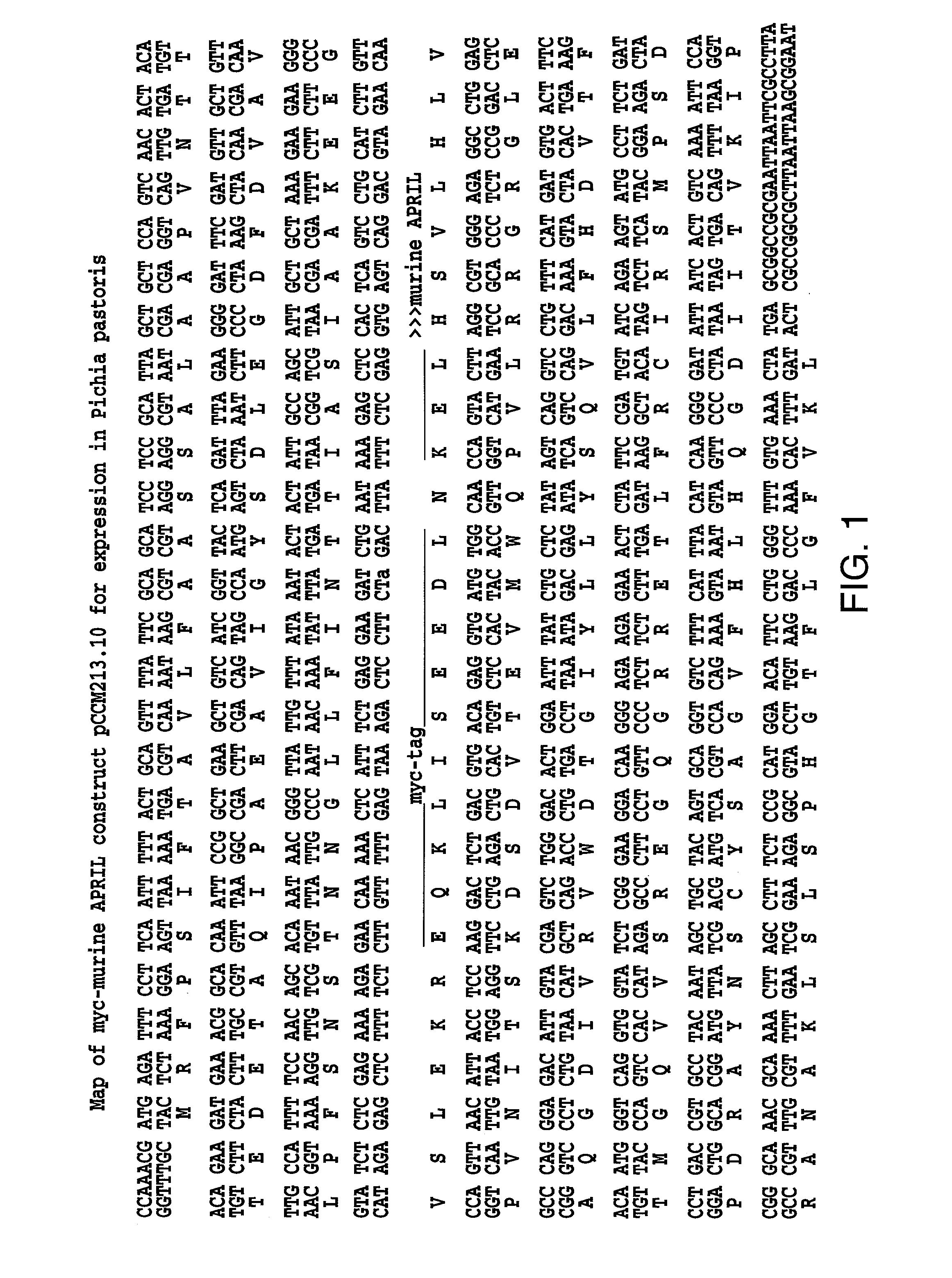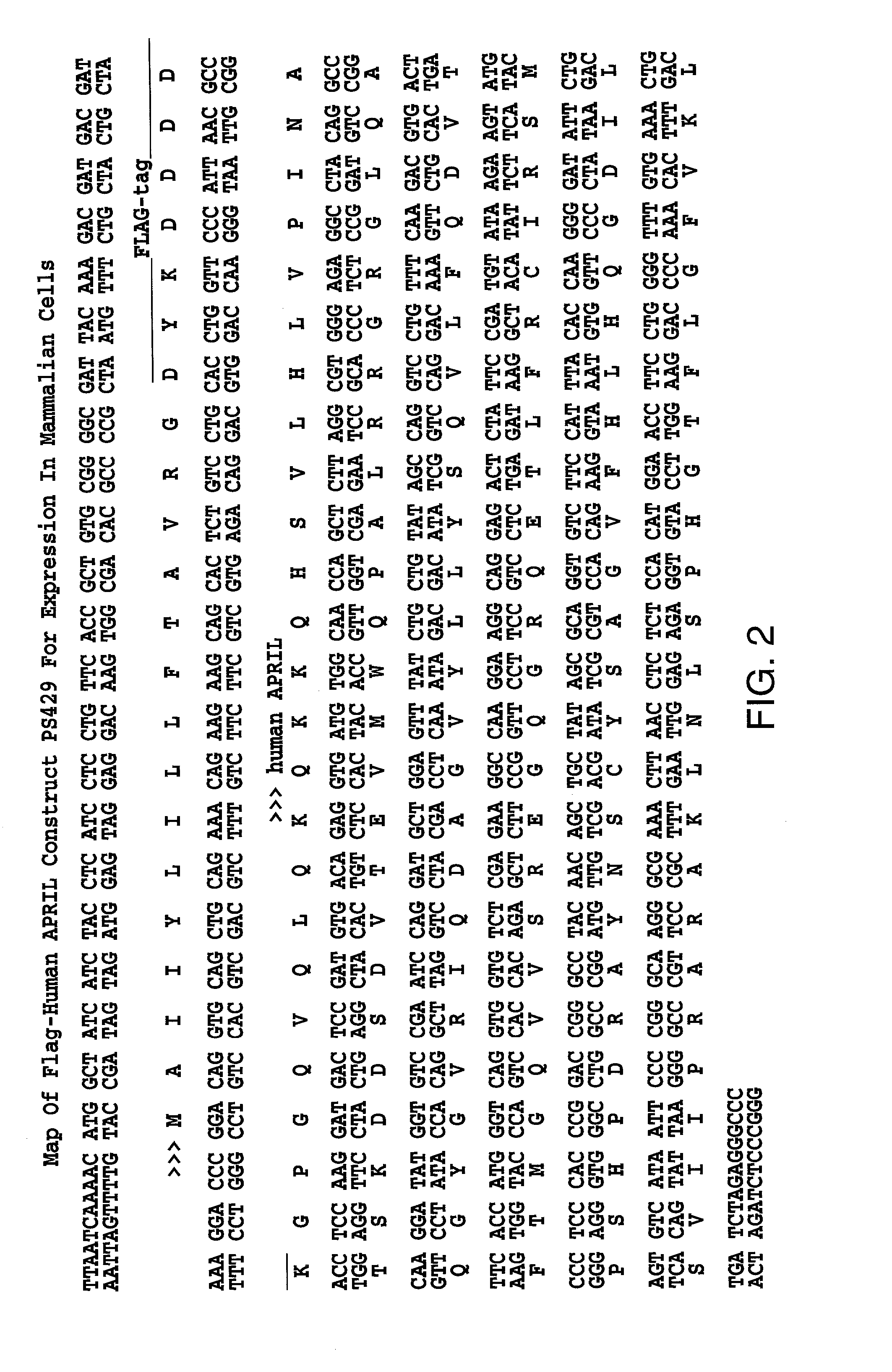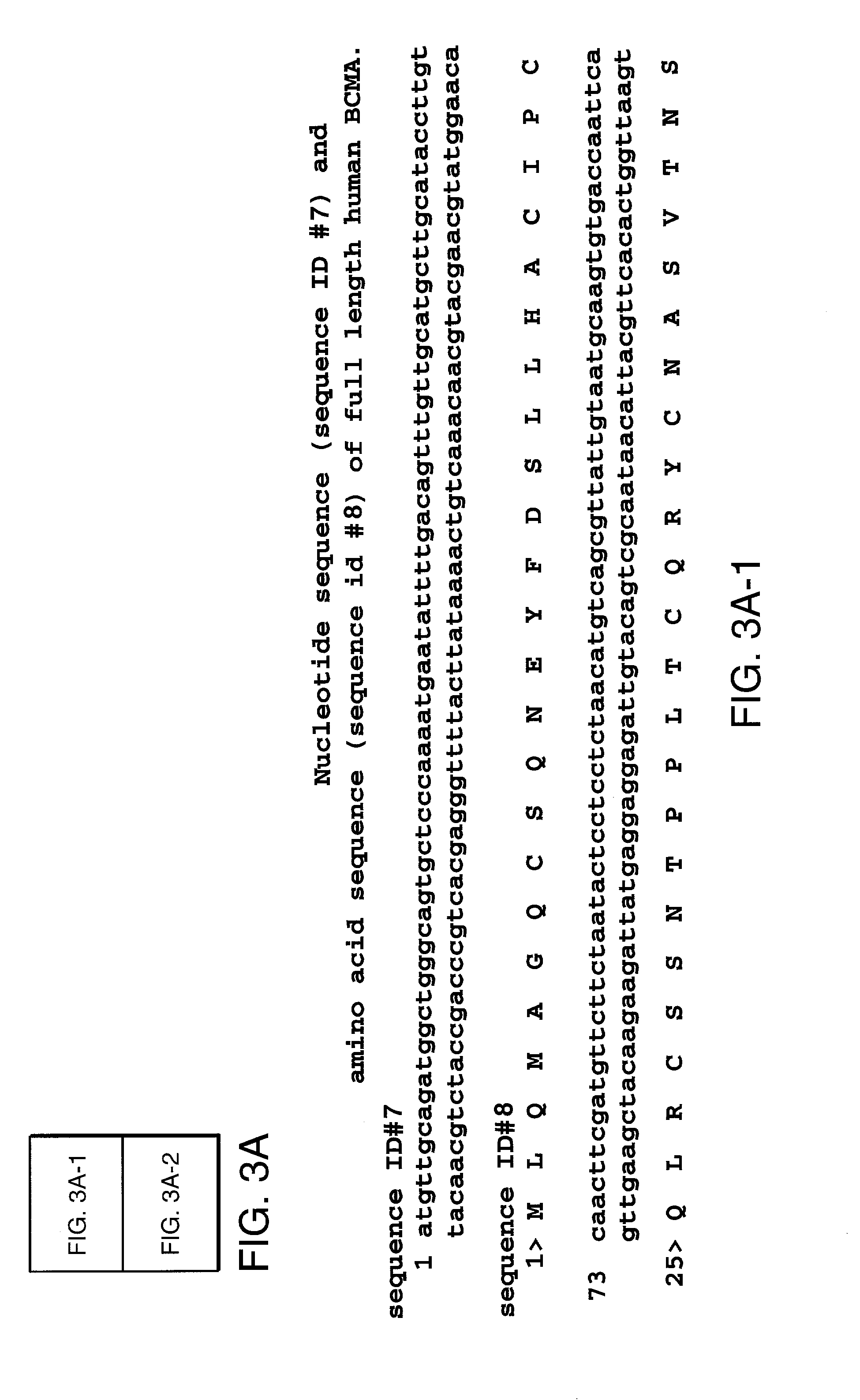Methods of treating a tumor that expresses APRIL by administering BCMA
a tumor and april technology, applied in the field of cancer treatment, can solve the problems of limited use of trail as an anti-tumor agent in some settings, and the current treatment of cancer is inadequate for many tumor types, so as to prolong the life, maintain the quality of life, and prolong the effect of li
- Summary
- Abstract
- Description
- Claims
- Application Information
AI Technical Summary
Benefits of technology
Problems solved by technology
Method used
Image
Examples
example 1
Detection of APRIL Binding to APRIL-R Using a Plate Assay
[0095]In this example, BCMA Association with April was tested.
[0096]In order to test whether BCMA associates with April we performed a co-immunoprecipitation experiment. Both soluble proteins hBCMA-Fc and myc-mApril were used in this experiment.
[0097]HBCMA-Fc and LTbR-Fc were added with different TNF ligands: myc-mApril; myc-CD40L and myc-RANKL into media containing 10% FBS for ½ hour at room temperature. Fc proteins were bound to protein A beads for 1-2 hours, washed three times with 1 ml of PBS, analyzed by immunoblotting with mouse monoclonal 9E10 (anti-myc) antibody and developed using enhanced chemiluminescence.
[0098]We detected myc-APRIL in hBCMA-Fc immunoprecipitates indicating that BCMA interacts with April in a specific way since other TNF ligands, myc-CD40L and myc-RANKL did not have the ability to bind to BCMA. Myc-April does not associate with LTbR-Fc.
[0099]The same membrane was stripped and reblotted with anti-hIG...
example 2
hBCMA Binds to Flag-hAPRIL
[0100]This example describes that hBCMA-FC interacts with FLAG-hAPRIL.
[0101]ELISA analysis: Coated plates with receptor-Fc fusion proteins (hBCMA-Fc-739 or hTNFR2-Fc-492) at 1 ug / ml in carbonate pH 9.6, overnight, 4C. Blocked for 2 hours at room temperature using PBS / 5% non fat dry milk / 05% Tween-20. 2× serial dilution of ligands were made in 100 ul of blocking buffer (TNFa-197 from 1000 ng / ml, muBAFF-657 from 1000 ng / ml, hApril-507 from 2000 ng / ml (inactive), hApril-429 from 5× concentrated media). After incubation with ligands the plate was washed in PBS) 0.5% Tween-20 and probed with 0.5 ug / ml anti-FLAG mAb M2 in dilution buffer. The antibody was then detected using anti-mouse-PO 1 / 2000 with enzymatic development (OPD).
[0102]Immunoprecipitation experiments: 293T cells were transfected with indicated expression plasmid (Rec-Fc or flag ligand) in 9 cm plate. Transfected cells were left for 5d in 8 ml Optimem media (Gibco-BRL). Immunoprecipitation were perf...
example 3
BiaCore Analysis
[0103]This example describes the binding of myc-mAPRIL; hKayL-440 (hBAFF); and Flag-mBAFF to hBCMA-Ig, hLT-R-Ig, or hp80 TNFR-Ig. All experiments were performed at 25C with a 10 ul / ml minute flow rate.
[0104]Each experiment was performed using HBS buffer (10MM HEPES, 150 mM NaCl, 0.005% P20 surfactant, at pH 7.4). The same solution was used both as running buffer and as sample diluent.
[0105]The CM5 chip (BIAcore, Inc.) surface was first activated with N-hydroxysuccinimide / N-ethyl-N′-(3-diethylaminopropyl)-carbodiimide hydrochloride (BIAcore). Twenty ul of hBCMA-Ig; fifteen ul of hLT-R05-Ig and 10 ul of hp80-TNFR, diluted to 30 g / ml in 10 mM acetic acid were then blocked with once with 30 ul and again with 15 ul of ethanolamine-HCL (pH 8.5). This resulted in a surface density of 1600-3700 resonance units (RU). The chip was regenerated with 20 ul of 1 mM formic acid. These rejections were repeated five times to establish a reproducible and stable baseline.
[0106]For the ...
PUM
| Property | Measurement | Unit |
|---|---|---|
| Fraction | aaaaa | aaaaa |
| Fraction | aaaaa | aaaaa |
| Time | aaaaa | aaaaa |
Abstract
Description
Claims
Application Information
 Login to View More
Login to View More - R&D
- Intellectual Property
- Life Sciences
- Materials
- Tech Scout
- Unparalleled Data Quality
- Higher Quality Content
- 60% Fewer Hallucinations
Browse by: Latest US Patents, China's latest patents, Technical Efficacy Thesaurus, Application Domain, Technology Topic, Popular Technical Reports.
© 2025 PatSnap. All rights reserved.Legal|Privacy policy|Modern Slavery Act Transparency Statement|Sitemap|About US| Contact US: help@patsnap.com



